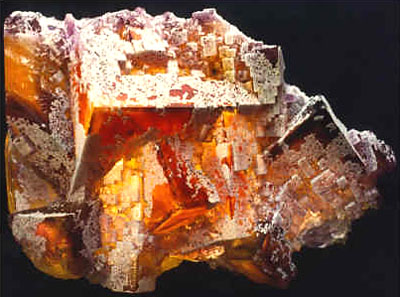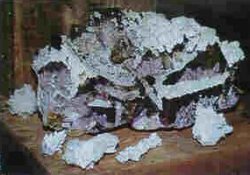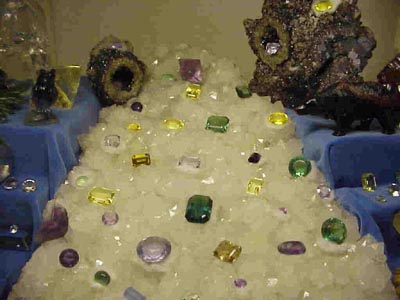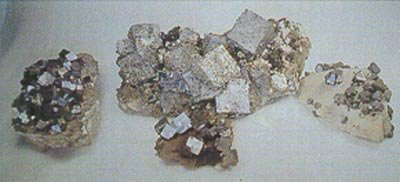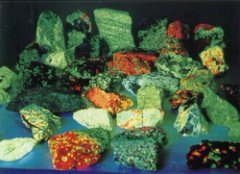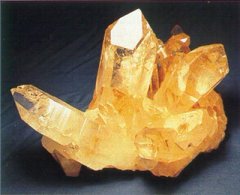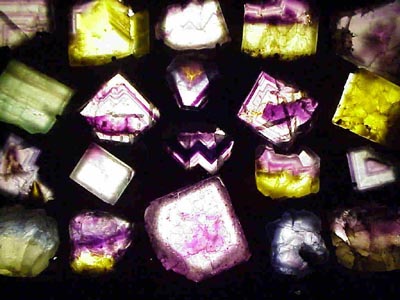 |
|||
|
|||
|
Copyright
Mineral Collection Draws World of Visitors to Marion, Kentucky
"John S. White, former curator of the gem and minerals collection of the Smithsonian Institution, represented the Clement Mineral Museum at the Munich, Germany, show. His presentations and articles in pre-show catalogs really opened doors for us and exposed the museum to a world audience. As a result, we have received visitors from more than 40 countries. I think White's work with us makes a statement about the quality of the specimens we have on display," said Curator Ron Stubblefield.
"The collection includes thousands of fluorite crystalline specimens, weighing from a fraction of an ounce to hundreds of pounds," Stubblefield notes. "We have specimens of just about every color, shape and size imaginable. Most of the fluorspar samples were collected within 25 miles of the museum, however we have minerals from all over the world."
"Mr. Clement always said the mines in Southern Illinois produced more of the beautiful specimens than Kentucky because of their extensive bedded deposits of fluorite. The Kentucky mines produced mostly vertical veins of fluorite," Stubblefield observes. Stubblefield is confident it would be almost impossible to assemble such an extensive collection today. "The collection is widely varied in that each vein produced specimens unique in color and composition. The collection is at the same time specialized because it contains minerals and artifacts from the local geologic district. There are no working fluorspar mines in the district today. That makes it very unlikely that this collection could ever be duplicated or equaled," Stubblefield adds.
Most of the commercial fluorspar used in the U.S. today is now mined in China with smaller amounts imported from Mexico and South Africa. It is used in the production of steel and other metals; Teflon and aluminum cannot be produced without fluorite. Fluorine is considered the most active of all of the elements. Fluorspar is a source of hydrofluoric acid used in many industrial applications. Fluorspar based chemicals are used in the manufacturing of plastics, refrigerants, toothpaste, lens coatings, and a variety of other consumer and industrial products.
For years, the collection was housed at the Clement home, where Mr. Clement frequently gave personalized tours for scientists and students who specifically sought him out to study the collection. After Clement's death, his family started looking for a way to share the outstanding collection and the Ben E. Clement Mineral Museum was formed. His son, Ed Clement, is an active member of the museum board. "It was my father's dream, especially in the later years of his life, that the collection be on permanent display in Marion at a place accessible, not just to scientists and university groups, but also to the general public," Ed Clement observes. "The museum has also preserved old photographs, maps, letters, records, and other items of historical and geological significance from my father's personal files and mining operations. We have preserved my father's office and plan to display it in the museum, pretty much the way it looked in our home." Ed Clement has spent a lot of time interviewing former fluorspar miners to preserve the history of mining in the region. He believes his father would be especially pleased that a lot of others in the area have donated materials and items that have allowed to the collection to grow. "We've had people bring us old mining equipment that would otherwise have continued rusting away. We've received photos of mining operations that might have been lost. We're collecting artifacts that start with beads from the Mississippian Indian era and include a wedge used in iron production in the area from the 1700's. We're talking about hundreds of years of mineral and mining history that would have disappeared without this preservation effort," Clement said. The museum is a living memorial to those who made the industry happen. There is a continuing effort to improve and expand the exhibits, including the installation of special lighting to accentuate the light reflecting qualities of the minerals.
Ben Clement graduated from Vanderbilt University in Nashville in 1915 with a degree in science. He completed aviator's school near the end of World War One. He was drawn to Kentucky by his interest in the fledgling fluorspar industry which was centered in Crittenden County and just across the river in Hardin County, Illinois. He served as head of the science department at Henderson (KY) High School from 1920-1922. He organized the Alpine, Holly, Davenport, and National Fluorspar Companies from 1919 to 1950. His family still owns the Holly mine site today.
Museum LocationThe Ben E. Clement Mineral Museum is located at 205 North Walker Street in Marion, Kentucky 42064. Signs will help direct you to the museum from the downtown court house at the intersection of U.S. 60/641 and Kentucky 91. The museum is open Tuesday through Saturday 9:00 a.m. to 3:00 p.m. For more information call 270-965-4263, or for a map go to the museum's website at www.clementmineralmuseum.com.
Contact Information
Permission is given to freely reprint this article from the Canadian Rockhound for non-commercial and educational purposes, provided the author, the Ben E. Clement Museum, and the Canadian Rockhound are acknowledged, and that the website URL address of the Canadian Rockhound is given. The article may not be edited or rewritten to change its meaning or substance without the author's permission. To contact the author, please use the e-mail address provided. The preceding article was a press release by Ron Stubblefield, Curator of the Ben E. Clement Mineral Museum, dated Thursday, December 30, 1999. Photographs were provided courtesy of Mr. Keith Todd from the Ben E. Clement Mineral Museum.
|
||||

Copyright © 2000 Canadian Rockhound
Magazine Issues |
News & Events |
Junior Rockhound |
Resources
|
||||
